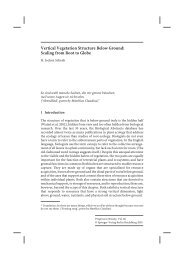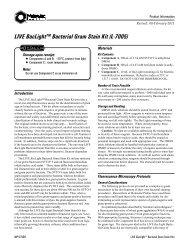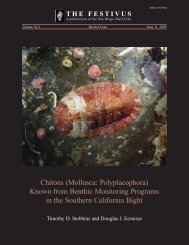Landscape Evolution at an Active Plate Margin - Biological Science ...
Landscape Evolution at an Active Plate Margin - Biological Science ...
Landscape Evolution at an Active Plate Margin - Biological Science ...
You also want an ePaper? Increase the reach of your titles
YUMPU automatically turns print PDFs into web optimized ePapers that Google loves.
end in a dextral shear system th<strong>at</strong> extends from the<br />
Indi<strong>an</strong> Wells Valley northward into the Owens Valley.<br />
This results in northwest-directed tr<strong>an</strong>stension, which<br />
is accommod<strong>at</strong>ed by normal <strong>an</strong>d strike-slip faulting.<br />
This necessit<strong>at</strong>es th<strong>at</strong> the Owens Valley fault must<br />
extend southward from Diaz Lake in the Alabama<br />
Hills, bene<strong>at</strong>h the sediments of Owens Lake, to the<br />
eastern side of the Coso R<strong>an</strong>ge where it steps west to<br />
the Little Lake fault. If so, the tectonic setting would<br />
be <strong>an</strong>alogous to southern De<strong>at</strong>h Valley, where basalts<br />
have been emplaced along the Black Mountain<br />
detachment formed by a right step in the Furnace<br />
Creek-Southern De<strong>at</strong>h Valley fault zone.<br />
Return to the vehicles <strong>an</strong>d Hwy 395, bearing left <strong>at</strong><br />
the c<strong>at</strong>tle guard.<br />
101.3 (0.2) Stop <strong>at</strong> pavement, w<strong>at</strong>ch for cross traffic.<br />
TURN LEFT (north) on Hwy 395.<br />
101.5 (0.2) Little Lake on the right is a spring-fed lake<br />
augmented by a low dam.<br />
101.9 (0.4) Continue past the turnoff to Little Lake<br />
R<strong>an</strong>ch (priv<strong>at</strong>e duck hunting club) to the right. Red<br />
Hill (the scoria cone just north of the turnoff) is<br />
straight ahead. Red Hill is one of the youngest volc<strong>an</strong>ic<br />
fe<strong>at</strong>ures in the Coso volc<strong>an</strong>ic field. It is thought to<br />
be no older th<strong>an</strong> 10,000 B.P. <strong>an</strong>d may have last experienced<br />
a fl<strong>an</strong>k eruption within the last 1000 years. The<br />
fl<strong>an</strong>k eruption is marked by a small cr<strong>at</strong>er th<strong>at</strong> lies<br />
on the northwest side of the cinder cone <strong>an</strong>d is best<br />
seen traveling south on Hwy 395. CEMEX currently<br />
oper<strong>at</strong>es the Red Hill Quarry on the south fl<strong>an</strong>k of<br />
the cinder cone. They have a small crusher pl<strong>an</strong>t th<strong>at</strong><br />
produces a fine scoria aggreg<strong>at</strong>e used for road cinders<br />
<strong>an</strong>d in the m<strong>an</strong>ufacture of cinder block, as well as<br />
larger-sized m<strong>at</strong>erial utilized for l<strong>an</strong>dscaping.<br />
104.6 (2.7) Continue past a right (east) turn <strong>at</strong> Cinder<br />
Road to Fossil Falls BLM campground. Continue<br />
north on Hwy 395. The Fossil Falls campground <strong>an</strong>d<br />
interpretive n<strong>at</strong>ure walk lie a short dist<strong>an</strong>ce along this<br />
road. Fossil Falls gets its name from the basalt outcrop<br />
th<strong>at</strong> marked <strong>an</strong> active w<strong>at</strong>erfall or rapids in the<br />
Owens River during times of a wetter clim<strong>at</strong>e. The last<br />
major overflow of w<strong>at</strong>er from the Owens River into<br />
China <strong>an</strong>d Searles Lakes probably occurred about<br />
4,000 years ago (B<strong>at</strong>es, this volume). The potholes in<br />
the basalt <strong>at</strong>test to the w<strong>at</strong>er’s velocity. The basalt here<br />
is typical of the Little Lake Basalt, with prominent<br />
olivine phenocrysts.<br />
109.4 (4.8) Coso Junction Rest Stop. Trees <strong>an</strong>d greenery<br />
to the west <strong>at</strong> 9:00 mark the trace of the SNFF.<br />
D. R. Jessey <strong>an</strong>d R. E. Reynolds<br />
Three lines to the west are: upper, old LADWP aqueduct<br />
(1913); center, Southern Pacific railroad to Lone<br />
Pine; lower, new LADWP aqueduct (1967).<br />
112.3 (2.9) Northeast <strong>at</strong> 1:30 you c<strong>an</strong> see <strong>an</strong> <strong>an</strong>cient<br />
l<strong>an</strong>dslide th<strong>at</strong> blocked the drainage of the Owens<br />
River. The river subsequently cut through the toe of<br />
the slide <strong>an</strong>d resumed its normal ch<strong>an</strong>nel.<br />
112.4 (0.1) Dunmovin.<br />
112.9 (0.5) Continue past a right turn to the Haiwee<br />
Power Pl<strong>an</strong>t.<br />
116.2 (3.3) Continue past a right turn on Haiwee<br />
Road leading to the reservoir. Haiwee Reservoir,<br />
to the east, marks the southernmost “lake” in the<br />
LADWP system for the eastern Sierra. Two intakes,<br />
one constructed in 1913 <strong>an</strong>d the second in 1970, draw<br />
w<strong>at</strong>er from the reservoir. From this point southward<br />
to Los Angeles, the Owens River flows only in aqueducts.<br />
The high peak on the Sierra crest <strong>at</strong> 10:00 is<br />
Ol<strong>an</strong>cha Peak (el. 12,122 ft).<br />
117.1 (0.9) Haiwee C<strong>an</strong>yon Road is on the left.<br />
119.2 (2.1) Continue past Lakeview Road. Veget<strong>at</strong>ion<br />
marks the SNFF scarp (west).<br />
120.9 (1.7) Sage Fl<strong>at</strong> Road junction. Continue on<br />
Hwy 395.<br />
122.1 (1.2) North Haiwee Road crosses spurs of the<br />
S. P. railroad th<strong>at</strong> served during construction of the<br />
LADWP aqueduct.<br />
122.8 (0.7) Cross the LADWP aqueduct.<br />
124.1 (1.3) Continue past a right turn to Cactus Fl<strong>at</strong>.<br />
124.5 (0.4) Continue past a left turn to Walker Creek<br />
Road <strong>an</strong>d a wild burro refuge.<br />
125.5 (1.0) The historical marker commemor<strong>at</strong>es the<br />
Farley Ol<strong>an</strong>cha mill site. Look east to the Plio-Pleistocene<br />
basalt of the Darwin volc<strong>an</strong>ic field th<strong>at</strong> drapes<br />
the south end of the Inyo Mountains. The basalt covers<br />
Paleozoic sedimentary rocks <strong>an</strong>d metamorphosed<br />
Mesozoic volc<strong>an</strong>ics <strong>an</strong>d sediments.<br />
126.0 (0.5) Continue past the junction with CA 190<br />
<strong>an</strong>d continue north on Hwy 395 toward Lone Pine.<br />
CA 190 heads east across the Darwin Pl<strong>at</strong>eau <strong>an</strong>d<br />
P<strong>an</strong>amint Valley before descending into De<strong>at</strong>h Valley.<br />
127.5 (1.5) The Crystal Geyser bottled w<strong>at</strong>er pl<strong>an</strong>t<br />
is on the right. This pl<strong>an</strong>t beg<strong>an</strong> producing bottled<br />
w<strong>at</strong>er in 1990. Since then, two additional pl<strong>an</strong>ts have<br />
16 2009 Desert Symposium
















